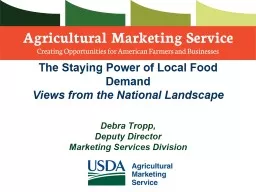PPT-The Changing Landscape of Acquiring Local Food—and What It Means for You
Author : aaron | Published Date : 2019-06-21
Carlos Coleman and Debra Tropp Local Food Research and Development Marketing Services Division March 14 2018 Contents of presentation How do we USDA AMS MSD support
Presentation Embed Code
Download Presentation
Download Presentation The PPT/PDF document "The Changing Landscape of Acquiring Loca..." is the property of its rightful owner. Permission is granted to download and print the materials on this website for personal, non-commercial use only, and to display it on your personal computer provided you do not modify the materials and that you retain all copyright notices contained in the materials. By downloading content from our website, you accept the terms of this agreement.
The Changing Landscape of Acquiring Local Food—and What It Means for You: Transcript
Download Rules Of Document
"The Changing Landscape of Acquiring Local Food—and What It Means for You"The content belongs to its owner. You may download and print it for personal use, without modification, and keep all copyright notices. By downloading, you agree to these terms.
Related Documents














